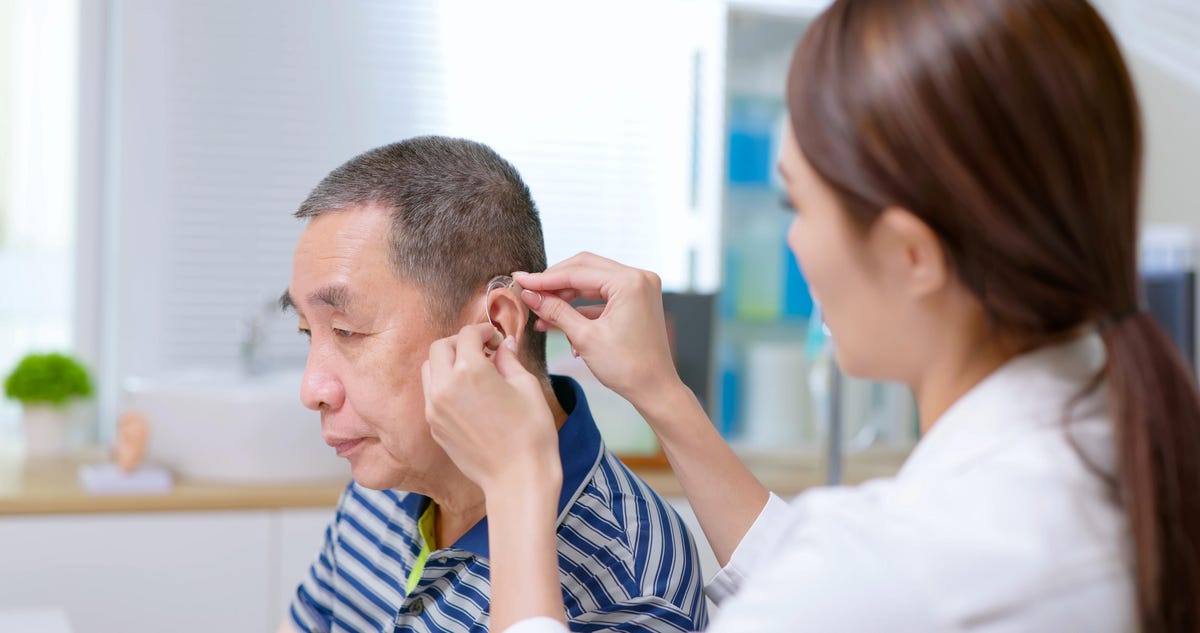Hearing loss might be more common than you’d think. About one in three adults between the ages of 65 and 74 have some degree of hearing loss, and about half of us will have difficulty hearing by the time we surpass 75. Hearing loss can also occur in younger people who have a genetic or health condition, or may have damaged hearing from frequent exposure to loud music or noisy environments and work places.
It should be no surprise, then, that a push to make hearing aids more available has been underway for years. They aren’t covered by most insurance providers, including original Medicare plans. But in August, the US Food and Drug Administration announced that its finalized rule will allow hearing aids to be sold over the counter, without a prescription or doctor’s visit, effective Oct. 17.
Federal health officials said that allowing people to access hearing aids OTC will make them a more affordable and convenient product for the roughly 30 million American adults who need one. But even with significantly reduced cost — saving people hundreds or even thousands of dollars for a pair — many over-the-counter hearing aids will still cost a pretty penny.
And while improved access to hearing health is a “phenomenal” development, there’s a lot more to consider when someone is getting care for hearing loss, including finding the right fit for a hearing aid, as well as someone’s processing of language and sound.
“It really isn’t just the device,” said Tricia Ashby-Scabis, senior director of audiology practices at the American Speech-Language-Hearing Association.
Read more: Sony Announces New Over-the-Counter Hearing Aid
What types of hearing aids will be sold OTC?
Air-conduction hearing aids, which fit either in the ear canal or sit behind the ear, will be available to adults with “perceived mild or moderate hearing loss,” per the FDA. Air-conduction hearing aids are the most common hearing aid type, according to Ashby-Scabis, and they work by moving sound down the ear canal throughout the ear. Other types of hearing aid devices include cochlear implants or bone-anchored systems.
An exact test on how to gauge your hearing loss as “mild or moderate” isn’t clear at this point, however, since over-the-counter models won’t be available for a couple more months. But Ashby-Scabis guesses that many hearing-aid makers will use an accompanying app that someone can use to test their hearing – others may be more simple. But the fact that people will need to decide for themselves what kind of hearing loss they have (and potentially miss a more severe type of loss or other health concern), is one of the bigger issues with over-the-counter hearing aids, according to Ashby-Scabis.
“That’s going to be a little confusing for folks, because how do you know what degree of hearing loss you have?”
Read more: New Bose, Lexie Hearing Aid to Enter Over-the-Counter Market

Children and adults with severe hearing loss will still need a prescription hearing aid. Many adults who qualify for an over-the-counter hearing aid (those with mild or moderate hearing loss) will benefit from seeing an audiologist to rule out other health concerns.
Karunyapas Krueklad /EyeEm/Getty Images
Who should get an over-the-counter hearing aid?
The FDA cleared over-the-counter hearing aids for adults with “perceived mild to moderate hearing impairment.” Ashby-Scabis says you’ll probably be a good candidate for getting one over-the-counter if you’re just starting to notice your hearing changing. People might sound like they’re mumbling often, or you could have a harder time listening to people with higher-pitched voices, like women and children.
If that’s you, you might be a great candidate for an over-the-counter hearing aid and might not need a more extensive exam from an audiologist.
“It’s usually at that very early level, where people are starting to lose some of that hearing, that I’d say, ‘That’s a great person to think about an over-the-counter hearing aid,'” Ashby-Scabis said.
When and where will they be available?
The FDA’s rule clearing some hearing devices for over-the-counter sale goes into effect Oct. 17. You can expect some pharmacies, retail stores and online sellers to have models available then. Best Buy, for example, announced this week that it will be selling hearing aids, including ones made by Lexie Hearing, Eargo 6 and more.
Don’t expect all hearing aid companies to fully embrace over-the-counter sales, however. Brandon Sawalich, president of hearing aids manufacturer Starkey, said that while he appreciates the FDA listening to the advice of some in the hearing industry by implementing output volume limits, hearing health is individual, and fitting someone for a hearing aid has “got to be done right.” Prescribing nonspecific over-the-counter models threatens user satisfaction with hearing aids, which is relatively high, despite the stigma around hearing aids persisting.
“Hearing is health care,” Sawalich said, adding that a hearing aid is “not a consumer electronic device.”
Starkey will sell over-the-counter hearing aids, Sawalich said, but only at hearing clinics in a more medical setting.

People who are just beginning to lose their hearing will probably be good candidates for an over-the-counter hearing aid, says Tricia Ashby-Scabis, an audiologist with the American Speech-Language-Hearing Association.
PonyWang/Getty Images
How much will they cost?
It’s too soon to say for sure, but one estimate puts the average around $600 to over $1,000 for a pair. The White House said the FDA’s new rule could save someone nearly $3,000 for a pair of hearing aids.
There will probably be a wide price range for over-the-counter hearing aids, similar to the varying price range for prescription hearing aids, which stretch from a few hundred dollars to over $5,000 for a pair, depending on what you need or how many bells and whistles you’d like your hearing aid to have. So, even if they’re technically more affordable, they still won’t be cheap. While over-the-counter hearing aids solve an accessibility problem and help people get their foot in the door for what Ashby-Scabis calls a “starter hearing aid,” the price will likely still be a barrier for some people.
“The majority of people who can’t afford that $1,000 pair of hearing aids aren’t going to be able to afford the $700 pair of over-the-counter hearing aids, or the $500 pair of hearing aids,” she said.
What happens when hearing health is neglected?
Research shows that hearing loss can lead to mental health problems, including depression, anxiety and social isolation. That’s because not being able to effectively communicate anymore erodes a major part of what it means to interact with the outside world.
To be able to communicate effectively is “the ability to express yourself and receive information from other people,” Ashby-Scabis said. “It’s how we make those connections.”
And if we don’t use the part of our brain that processes information and language through hearing, it will weaken over time and may even lead to cognition problems. The fact that people may be more likely to access a hearing aid in the beginning stages of hearing loss is perhaps the biggest benefit to OTC sales, in Ashby-Scabis’ eyes. It will help prevent them from going from zero to 100, and being forced to adapt and refire the language part of their brain when they’ve gone 10 or 15 years not being able to fully hear or communicate. Instead, they can transition as needed, hopefully a little earlier with an over-the-counter hearing aid.
“It’s almost like they’re putting their ears on an exercise routine,” Ashby-Scabis said.
The information contained in this article is for educational and informational purposes only and is not intended as health or medical advice. Always consult a physician or other qualified health provider regarding any questions you may have about a medical condition or health objectives.
New FDA Rule in Effect: What to Know About Over-the-Counter Hearing Aids – CNET
Source: Media Star Philippines


0 Comments